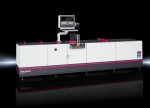Solving the warehouse automation challenge
Published: 15 February, 2019
Warehouse operators need expert help if they are to implement the most appropriate automation solution for their operations. Therefore choosing the correct partner is critical, Neil Beaumont at Lenze explains.
The rise in online shopping has required huge efficiency gains in warehouse operations. To meet the demands of e-commerce fulfilment, companies must handle high volumes of diverse products at ever-increasing speeds. One factor behind improved warehousing, and therefore order fulfilment, is using advanced conveying systems.
Automation is absolutely critical to the modern warehouse, and systems must be fast, agile and reliable. For manufacturers of warehouse handling equipment, this creates conflicting challenges: customers require increasingly complex systems, which at the same time must be developed quickly while being easy to operate and understand.
Modern distribution centres use everything from conveyor systems to robots and automated guided vehicles which all need to be tightly coordinated. In addition, multiple sensors gather huge amounts of data and must communicate with many external systems. Within this, customers demand shorter development times, as well as simplicity in operation, minimal maintenance, standard components – to control spare parts inventories – and responsive service and support. It almost goes without saying that costs must also be kept under close control.
Warehouse operators are experts in their own business, so will need an expert partner to help them develop appropriate automation systems for their operations. However, choosing an automation supplier is a tough job. Warehouse companies must be sure that their chosen automation partner meets all their needs. But how is this done?
The simple answer is to choose a partner with a broad technology portfolio backed by a strong supply chain, solid design capabilities, in-service support and appropriate development tools. The challenge is to determine who can provide all this? This can be done by asking potential suppliers a number of incisive questions, in order to assess their worth.
Design insight
A deep understanding of automation is a critical attribute of a strong partner. While many customers know exactly what they need their machine to do in terms of load, travel and speed, they are not always experts in motion. For this, they must rely on their partner’s expertise.
Companies with products based on simple, unchanging designs will receive adequate service from a straight component supplier; but those involved in bespoke projects, that constantly incorporate new processes will require expert assistance.
A few key questions to ask potential suppliers in the area of design are:
• Do you have strong, relevant knowledge of this process?
• Can you provide dependable advice in the early stages?
• Do you offer skills support – such as application engineering training?
Broad portfolio
All designs must eventually be converted into a bill of materials, which requires a partner with a broad portfolio of products and the knowledge to apply them.
One key factor is whether components connect seamlessly. It seems natural that a single supplier should be able to do this. However, portfolios can grow through acquisition – meaning that two parts from the same supplier may have been designed in isolation. It can take time before ‘new’ parts become fully integrated.
Many major suppliers have portfolios such as these. The key factor is whether they can provide guidance on these limitations.
Some key questions to ask in the area of Products are:
• Is your portfolio scalable, complete and modular? (Also, is it fully integrated – from a common design team?)
• What is the span of power requirements of your products?
• Can the portfolio cover everything from simple to complex applications – baseline, stateline and topline?
Technology selection
An expert can also help to choose the most appropriate and cost-effective technology. For instance, it might seem right to specify servo motors in a warehouse automation system. However, while these are ideal for dynamic, high-speed applications such as packaging and wrapping machinery they are probably over-specified in material handling. So, a simpler solution, such as a conventional motor with inverter drive, is more appropriate – while also being less costly.
Supply chain strength
Once the components are in place they need to be delivered quickly and reliably – which requires a strong supply chain. In many industries, supply continuity is critical. Customers may need a guaranteed supply of parts for three or more years, so needs to know this can be achieved.
Well-prepared companies assess a potential supplier’s long-term strength before anything else. They need to ensure that if they make changes, such as adding new production in a foreign country, it will be supported.
If a supplier can support this, it is critical that its production and quality control processes are equally strong in all locations. So, component supply to each region must be able to cope with this with no variation in quality, and no variation in lead times.
Some key questions to ask regarding Supply Chain are:
• Does your company have long-term financial strength?
• Can you support a range of specific delivery options – such as to key overseas locations – over a number of years?
• Are your quality management systems consistent in each location?
Support level
Even the most basic of component suppliers should provide a high level of service and back-up. In order to assess this, a company needs to ask: is this supplier truly capable of working with me for an entire project?
Some key questions to ask regarding Service Support are:
• Is support comprehensive, and does it fit with market needs such as offering extended warranty?
• What’s your product obsolescence policy and is it published?
• Is support available for machine-life extensions?
Development tools
Just a few years ago, software development tools were not so important in the development of automation solutions but these days they are crucial. Software tools are used across all stages of a machine’s lifecycle from project planning and design through to programming, diagnostics and maintenance.
All machines are different, but most combine common functions. The best automation development environments provide ready-made, tested modules that handle these kinds of basic machine functions. This modular approach makes engineering quick, easy and reliable. It helps automation specialists to work with a basic architecture.
Some key questions to ask regarding Development Tools:
Do you offer easily accessible tools for a range of applications such as application assessment, project planning, programming and maintenance?
Is there easily accessible product documentation?
Can the tools help me cope with multiple ‘what if’ scenarios?
In conclusion, it is worth remembering that customers have very different automation needs, which will require varying levels of expert assistance. However, using these pointers will help to identify the strengths and weaknesses of a potential automation partner and help you choose one who can help to enable faster machine development and lower costs.






 Manufacturing switchgear can be very labour intensive, despite the advances in automation, there is still a huge amount of manual work involved in cutting and machining busbars, support rails and cable ducts. RITTAL AUTOMATION SYSTEMS says it is now offering new and improved machines and tools that will help automate or part-automate these previously time-consuming activities.
Manufacturing switchgear can be very labour intensive, despite the advances in automation, there is still a huge amount of manual work involved in cutting and machining busbars, support rails and cable ducts. RITTAL AUTOMATION SYSTEMS says it is now offering new and improved machines and tools that will help automate or part-automate these previously time-consuming activities.
